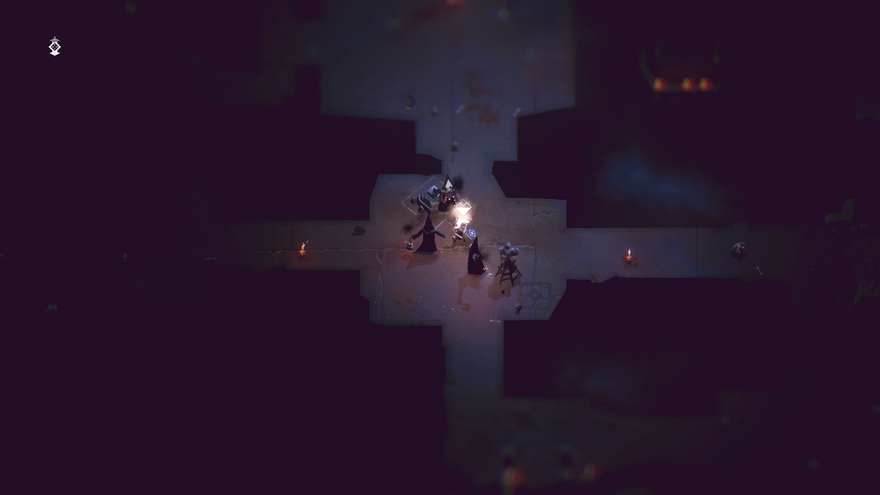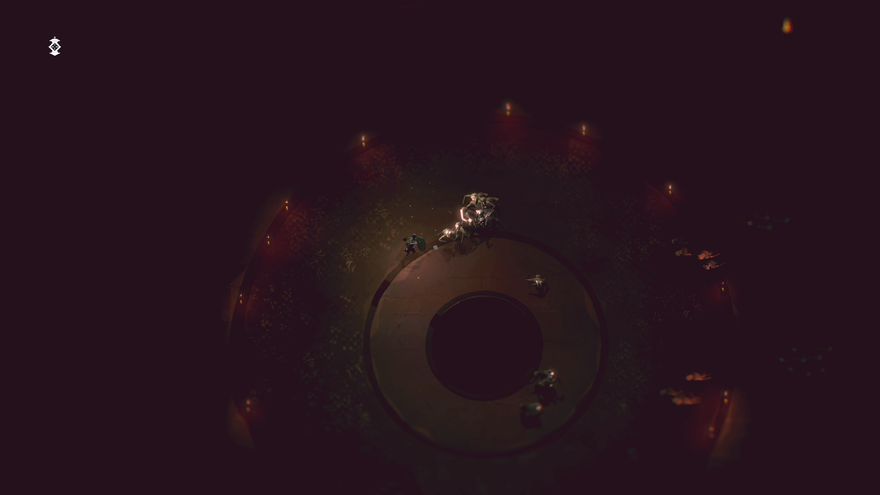Capybara’s Below has beguiled since it was first debuted—mysterious, sprawling, and rarely seen. At E3, Kill Screen sat down with the game’s creative director Kris Piotrowski to discuss how the game came to be.
///
Jamin Warren: So how long have you guys been working on Below?
Kris Piotrowski: How long … I don’t want to say how long in total. I will say that I think we announced it a little bit too early.
JW: Gotta keep the people you know.
KP: Definitely we’ve been working on it a long while. It’s the most complex game. It’s also the biggest game we’ve ever made. It’s also in my opinion the most mechanically deep game that we’ve ever made.
JW: What do you mean by complex?
KP: I mean like the systems are complex, the tech is complex, conceptually it’s complex.
JW: What systems have you built into the game that were tough for you?
KP: Well one of the core systems is the procedurally generated levels. So that in itself is a complex system. But related to that there’s a sort of survival system as well that has to do with crafting and temperature and getting hungry—all that kind of stuff you sort of see in other survival games. But we also have other elements as well. We have like a soup-cooking system in the game.
JW: Are you guys big soup people?
KP: I love soup. My mom is in my opinion the best soup maker on the planet. I was trying to think of a way to sort of ground the crafting and sort of pace it out the right way. So what we landed on was the idea of creating tools out of materials but also being able to, in-between levels, stop at a fire, sit down, and kind of prepare yourself for the next wave of the journey. And the more you sort of know about the game world, the more you know what you have to have in your backpack before you jump into it.

JW: Yeah, I just ate all my food. I didn’t realize there was crafting, so oh well. So there’s soup-making as it were.
KP: Yeah, and there’s a whole bunch of other things that we haven’t even really shown yet. We’re aiming to reveal a very big part of the game that we’ve hinted at with other trailers. Probably PAX Prime will be the actual reveal of the main big thing we’ve been holding back before launch.
JW: Back to soup, what kind of soup did your mom make while you were a kid?
KP: All kinds. My background is Polish, so my mom would make, you know, the best chicken soup in my opinion. She makes amazing borsch. She makes amazing mushroom soup. She makes amazing—there’s a very specific pickle soup, she made it out of Polish ogorki. And it’s just a very kind of grimy, bitter, sour soup that only Polish people like, I think. It’s one of those flavors that when I have it, it rockets me back.
JW: Did you grow up in Poland?
KP: I was born in Poland but I immigrated to Canada when I was five.
JW: By yourself?
KP: By myself, just me, I just walked over. No, my family immigrated over. And yeah, I mean I don’t want to play up soup too much, but yeah, no, it’s been something. I also wanted to sort of make sure that every element of the game had a little bit more charm, that was a little more precious than other games that have similar kinds of systems.
JW: What do you mean by precious?
KP: I don’t know, like a little bit more of a delicate touch. Little bit simple. Little bit smaller.
JW: Do you have an example of that?
KP: I feel like kind of every little detail. I can’t think of a very specific thing, but everything from the way the character is animated to obviously Jim (Guthrie)’s music. The little touches that we add to that kind of stuff. I’m really trying to create something that just feels kind of delicate and small and precious, but also complex and deep and crazy and brutal and dark and awful.
JW: One of the immediate things is the character’s size. There’s a lot of unused space. A lot of times in games the entire screen is filled with stuff, at any given moment 50% of the screen is obscured. I was curious about how did you guys come to the conclusion that that was the best way to portray the character?
KP: The size and scale of the character was the very first idea that we had. The way the game kinda came about was I had this idea to use the HD space to create single-screen, full levels. So if you go into the actual game world and play the randomly generated levels, they generally fit to a single screen. So I wanted to create a game that had basically one screen equals a full fifteen minute experience where you’re very slowly crawling around every little inch of it.
JW: Right.
KP: You could end up in the corner just fighting little dudes, or see little bats flying around in this part of the screen and it feels like a big large space when it’s really just one screen. But the main kind of idea behind it, I thought there was something interesting about creating a game where—in a lot of games they got to position the camera right behind your shoulder, and the focus is really on you as a big powerful killing machine or superhero or whatever it is you are, and the world is very much situated around this character. Where with Below it kind of shifts the focus a little bit. Most of the screen is the world and you’re just a tiny little spec within it and because the character’s a very capable little dude, or not just a dude—it is randomly generated so at this scale all we do is swap the voices—it’s really anybody. But the main idea was to create something that made the character feel a little bit more like not really the main point of the visual, like you’re just exploring a big, oppressive, dark world but you’re a little fragile speck.

JW: Very Herman Melville, Red Badge of Courage—you’re the insignificant speck.
KP: You’re the little thing walking around messing with things in this world, but the world exists on its own and you’re only ever a tiny little fraction of it. So the feeling of being alone in a mysterious space, and also in a place that you don’t understand, and a dangerous space, and you’re just like a tiny little fragile point of light walking through it.
JW: I just went to the Grand Canyon a couple of weeks ago for the first time. It’s one of the rare moments where you become very small. The scale, the size of you is very apparent compared to this enormous thing. Have you ever had an experience like that?
KP: Oh yeah totally, I think I have that all the time. I’m constantly reading about everything that’s going on with space exploration, all that kind of stuff, that’s the stuff I’m super fascinated with. Just grasp your head around the tininess of your position in the universe. I personally think that Below only touches on that, but that is part of the feeling—that when you pull the camera back, it really becomes more about how you’re looking at everything else.
JW: Right.
KP: You know where you are but it’s not really about your character becoming a more powerful killing machine throughout this world. You’re always going to be this fragile, one-hit-away-from-death character. And it does make the game-world feel big, but in a different way. And I think that’s something that we were interested in trying to achieve right from the beginning, and it’s been a guiding light for us in every aspect of the game. Obviously the visual design has been designed to be legible and clear at this scale. Enemy design, combat design is built around clarity at this level. But then the interesting thing about it is we can hide little details. And there’s something about the game that I’ve noticed, the players, because of the scale, they kind of lean into it. There’s like a “Below lean-in.”
JW: So you should play the game vertically standing over your television. Were there any kind of non-game influences for the game to capture that sense of scale?
KP: One of the early videogame influences for the game was the Pixeljunk series. The Pixeljunk series for me was kind of the first series of games that I saw using the HD 2D style in a totally different way. For example, Pixeljunk Eden, or Pixeljunk Shooter, are really about a tiny little character just kind of navigating a larger space, and I thought that was super interesting and I really thought there was something there. That’s one of the main ideas that led me to think about this kind of idea. Outside of games, I don’t know if you know the book Gnomes?
JW: No, I don’t.
KP: Gnomes is an old book from the ‘70s. I don’t know the author’s name. It’s a book I had when I was a kid. And it’s a big thick book about kind of treating Gnomes as a real thing.
JW: Yeah.
KP: Like Gnomes live in this part of the world.
JW: These Iceland Gnomes are very real.
KP: Yeah, I’m not sure where it comes from, but as a kid, it was very scary. There’s something about it, treating a fantasy element but in a realistic way. So it dealt with Gnomes dying and their funeral rites, and what they eat in different areas. What different Gnomes are like. What Gnomes deal with. And it had these beautiful drawings of these tiny little characters with little red hats. And it was all treated very realistically. Like: Gnomes are real, this is what their life is like. These are their traditions. This is how they make splints out of wood when they break their legs. This small scale realism was something that I didn’t even realize had influenced me until I went back to it and looked at that book and was like, “Holy crap, a lot of Below is influenced by that.”
JW: Do you spelunk? Are you a cave person?
KP: No, I don’t spelunk. It’s one of those things that I could totally see myself wanting to do. I think I’d like to do that at some point. I do like hiking. I like exploring. I don’t spelunk too much. I do go inside caves, I’ve gone on tours through caves. But I haven’t strapped on the headlight and—
JW: Just lowered yourself down.
KP: Yeah or like crawl through some weird little space…

JW: What’s the last good you hike you did?
KP: Last good hike? I think the last good hike was probably when I was in San Francisco last time. I went to this Sutra Baths area and just explored all around that area. It wasn’t a backpack wilderness hike, but for someone from Ontario just being by the ocean by some cliffs was super amazing.
JW: Have you been to the badlands, the Cheltenham Badlands in Toronto?
KP: I have.
JW: When I was there that was one of the cooler things.
KP: Yeah it’s crazy.
JW: Like, “Look at this, look at this crazy thing that’s here.”
KP: Yea, it’s like lumps. It’s a totally weird space.
///
This interview has been edited for clarity and length.
